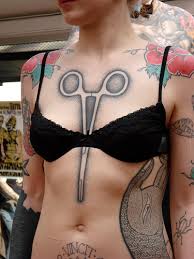
That big "I love you Donna" tattoo on your right bicep is really getting on your wife, Kathy's nerves, and for the sake of harmony in the marriage you decided to get it removed. You tried TCA and you tried tattoo removing creams, but all they did was fade the tattoo. It's still visible. So now you are considering tattoo removal surgery. What procedures are available and what is involved?
The two primary surgical removal procedures are tattoo excision and dermabrasion. Cryosurgery and laser tattoo removal may also be considered "surgery" in that they are performed in a doctor's office. This article doesn't address them, though.
Tattoo excision is cutting out the tattoo and sewing the skin back together. It is an out patient procedure, performed in the doctor's office. You will not be spending time in the hospital. If the tattoo is small, only one appointment is generally required, but larger tattoos may require multiple appointment.
A local anesthetic is applied and the top two skin layers containing the tattoo are removed. The skin is then stitched back together. As you might imagine, the tattoo will be gone, but a scar will remain. The size of the scar depends on the size of the tattoo removed.
With dermabrasion, the tattoo is literally "sanded" off. This is also an out patient procedure. A local anesthetic is applied and the tattoo is removed using a rotary abrasive brush that peels away the skin.
The wound must be carefully cared for because there is a very real danger of infection. If the tattoo was in many layers of the skin, a follow up treatment may be necessary. Significant scarring is a very real possibility with dermabrasion.
Because of the very real possibility of significant scarring, deciding on tattoo removal surgery should not be a hasty decision. Research all methods, their costs and their success rates. The tattoo you are having removed you once thought of as having forever. In all probability, the scars from surgery you will have forever.
Click Here for more free information on tattoo removal products and procedures, including tattoo removal costs.
The two primary surgical removal procedures are tattoo excision and dermabrasion. Cryosurgery and laser tattoo removal may also be considered "surgery" in that they are performed in a doctor's office. This article doesn't address them, though.
Tattoo excision is cutting out the tattoo and sewing the skin back together. It is an out patient procedure, performed in the doctor's office. You will not be spending time in the hospital. If the tattoo is small, only one appointment is generally required, but larger tattoos may require multiple appointment.
A local anesthetic is applied and the top two skin layers containing the tattoo are removed. The skin is then stitched back together. As you might imagine, the tattoo will be gone, but a scar will remain. The size of the scar depends on the size of the tattoo removed.
With dermabrasion, the tattoo is literally "sanded" off. This is also an out patient procedure. A local anesthetic is applied and the tattoo is removed using a rotary abrasive brush that peels away the skin.
The wound must be carefully cared for because there is a very real danger of infection. If the tattoo was in many layers of the skin, a follow up treatment may be necessary. Significant scarring is a very real possibility with dermabrasion.
Because of the very real possibility of significant scarring, deciding on tattoo removal surgery should not be a hasty decision. Research all methods, their costs and their success rates. The tattoo you are having removed you once thought of as having forever. In all probability, the scars from surgery you will have forever.
Click Here for more free information on tattoo removal products and procedures, including tattoo removal costs.














No comments:
Post a Comment